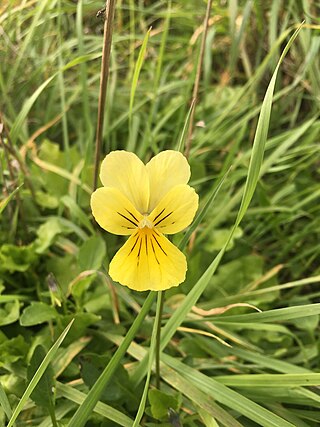
The garden pansy is a type of polychromatic large-flowered hybrid plant cultivated as a garden flower. It is derived by hybridization from several species in the section Melanium of the genus Viola, particularly V. tricolor, a wildflower of Europe and western Asia known as heartsease. It is sometimes known as V. tricolor var. hortensis, but this scientific name is suspect. While V. tricolor var. hortensisGroenland & Rümpler is a synonym of Viola × wittrockiana, V. tricolor var. hortensisDC. refers to a horticultural variety of wild pansy that had been illustrated in Flora Danica in 1777 before the existence of Viola × wittrockiana.

Viola is a genus of flowering plants in the violet family Violaceae. It is the largest genus in the family, containing over 680 species. Most species are found in the temperate Northern Hemisphere; however, some are also found in widely divergent areas such as Hawaii, Australasia, and the Andes.

Viola tricolor is a common European wild flower, growing as an annual or short-lived perennial. The species is also known as wild pansy, Johnny Jump up, heartsease, heart's ease, heart's delight, tickle-my-fancy, Jack-jump-up-and-kiss-me, come-and-cuddle-me, three faces in a hood, love-in-idleness, and pink of my john.

Gagea lutea, known as the yellow star-of-Bethlehem, is a Eurasian flowering plant species in the family Liliaceae. It is widespread in central Europe with scattered populations in Great Britain, Spain, and Norway to Siberia and Japan.

Polygala is a large genus of flowering plants belonging to the family Polygalaceae. They are commonly known as milkworts or snakeroots. The genus is distributed widely throughout much of the world in temperate zones and the tropics. The genus name Polygala comes from the ancient Greek "much milk", as the plant was thought to increase milk yields in cattle.

Polygala vulgaris, known as the common milkwort, is a herbaceous perennial plant of the genus Polygala in the family Polygalaceae.

Viola lutea, the mountain pansy, is a species of flowering plant in the Viola genus of the viola family, Violaceae. This evergreen perennial grows in Europe, from the British Isles to the Balkans.

Viola sororia, known commonly as the common blue violet, is a short-stemmed herbaceous perennial plant native to eastern North America. It is known by a number of common names, including common meadow violet, purple violet, woolly blue violet, hooded violet, and wood violet.

Lallemantia is a genus of flowering plants in the family Lamiaceae. It is named after the German botanist Julius Léopold Eduard Avé-Lallemant.

Viola purpurea is a species of violet with yellow flowers and the common name goosefoot violet.

Viola kitaibeliana, the dwarf violet, is a plant species in the genus Viola. It is native to a large area from the Canary Islands, across Europe, to northern Iran and southern Turkmenistan.

Billbergia pyramidalis, commonly known as the flaming torch and foolproof plant, is a species of bromeliad that is native to northern South America and parts of the Caribbean. It was first described by John Sims, and got its current name by John Lindley.

Cereus repandus, the Peruvian apple cactus, is a large, erect, spiny columnar cactus found in South America. It is also known as giant club cactus, hedge cactus, cadushi, and kayush.

Viola bertolonii is a species of violet known by the common name Bertoloni's pansy, belonging to the Violaceae family.

Schweiggeria is a genus of flowering plants in the violet family Violaceae, with one or two species, found in eastern Brazil.

Viola lutea subsp. calaminaria is a subspecies of V. lutea, in the violet family, the Violaceae. The plant occurs from Kelmis in the Belgian province of Liège across the borders to Germany and the Netherlands. The plant has adapted to an excess of zinc in the tailings of a former mine, the heaps of stone left over after separating the valuable fraction from the ore. By evolving the ability to cope with the toxic heavy metal pollution, this violet has gained an advantage over the other plants in the ecosystem, as is able to become the locally dominant floral component of such habitats.

Hladnikia is a monotypic genus of flowering plants belonging to the family Apiaceae. Its sole species, Hladnikia pastinacifolia, is a Slovenian paleoendemite, restricted to the area of only 4 km2, located in Trnovo Forest Plateau, karst plateau of Western Slovenia. German botanist Heinrich Gottlieb Ludwig Reichenbach named the genus after Carniolan botanist and founder of Ljubljana Botanical Garden Franz Hladnik.
Malesherbia solanoides is a subshrub native to the Atacama region of Chile. It was initially described in 1833 by Reise Erde.
















